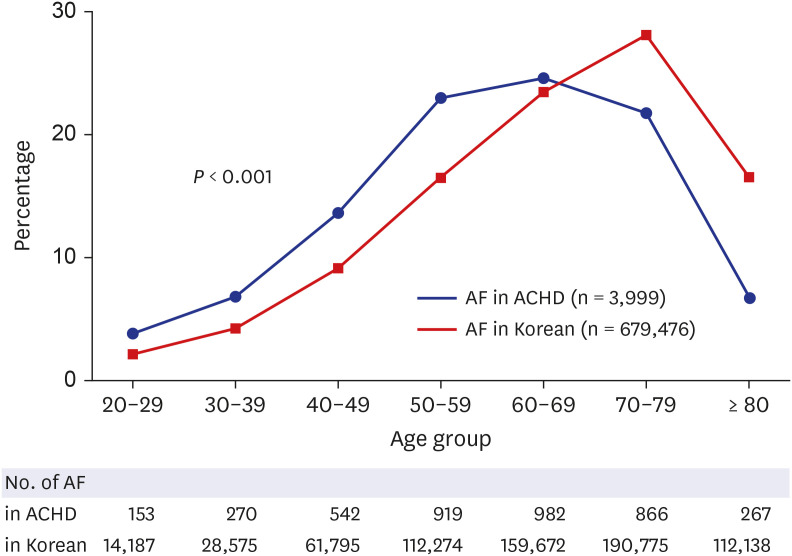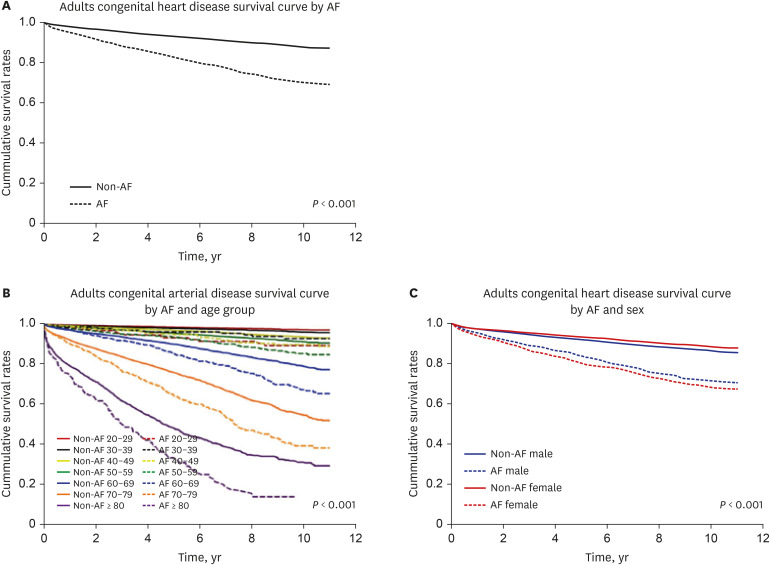J Korean Med Sci.
2021 Feb;36(5):e43. 10.3346/jkms.2021.36.e43.
Impact of Atrial Fibrillation on Survival in Adults with Congenital Heart Disease: a Retrospective Population-based Study
- Affiliations
-
- 1Division of Cardiology, Department of Medicine, Heart Vascular Stroke Institute, Samsung Medical Center, Sungkyunkwan University School of Medicine, Seoul, Korea
- 2Department of Pediatrics, Adult Congenital Heart Clinic, Heart Vascular Stroke Institute, Samsung Medical Center, Sungkyunkwan University School of Medicine, Seoul, Korea
- KMID: 2512465
- DOI: http://doi.org/10.3346/jkms.2021.36.e43
Abstract
- Background
The number of adults with congenital heart disease (ACHD) with atrial fibrillation (AF) is expected to increase. We sought to assess the impact of AF on survival in Korean ACHD.
Methods
Records of AF in ACHD were extracted from the records of the Korea National Health Insurance Service from 2006 through 2015. Multiple Cox proportional hazards analyses were carried out after adjustment for age, sex, income level, AF, and comorbidities.Survival rates (SRs) with and without AF were compared. The death records from 2006 through 2016 were included.
Results
A total of 3,999 ACHD had AF (51.4% were male) and 62,691 ACHD did not have AF (43.5% were male); the proportion of ACHD who were 60 years and older was 53.0% and 27.0% in those with and without AF, respectively (P < 0.001). The age-standardized incidence rate for AF was 1,842.0 persons per 100,000 people in the Korean general population from 2006 through 2015. For AF in ACHD, it was 5,996.4 persons per 100,000 ACHD during the same period, which was higher than that in the general population (P< 0.001). Significantly higher proportion of death (20.9%) occurred in ACHD with AF than without AF (8.3%) (P< 0.001). The adjusted hazard ratio for AF of death in ACHD was 1.39 (95% confidence interval, 1.29– 1.50). The ten-year SR of ACHD with AF was 69.7% whereas it was 87.5% in non-AF (P < 0.001).
Conclusion
In ACHD, AF occurs more frequently and has a worse prognosis than seen in the non-valvular general population in Korea. AF is associated with increased death in ACHD, especially with aging.
Keyword
Figure
Cited by 1 articles
-
A Retrospective Population-Based Survival Study of Idiopathic Pulmonary Arterial Hypertension in Korea
Shin Yi Jang, Eun Kyoung Kim, June Huh, Jinyoung Song, I-Seok Kang, Seung Woo Park, Duk-Kyung Kim, Sung-A Chang
J Korean Med Sci. 2022;37(10):e80. doi: 10.3346/jkms.2022.37.e80.
Reference
-
1. Ávila P, Mercier LA, Dore A, Marcotte F, Mongeon FP, Ibrahim R, et al. Adult congenital heart disease: a growing epidemic. Can J Cardiol. 2014; 30(12 Suppl):S410–9. PMID: 25432136.
Article2. Wasmer K, Eckardt L. Management of supraventricular arrhythmias in adults with congenital heart disease. Heart. 2016; 102(20):1614–1619. PMID: 27312002.
Article3. Miyasaka Y, Barnes ME, Gersh BJ, Cha SS, Bailey KR, Abhayaratna WP, et al. Secular trends in incidence of atrial fibrillation in Olmsted County, Minnesota, 1980 to 2000, and implications on the projections for future prevalence. Circulation. 2006; 114(2):119–125. PMID: 16818816.
Article4. Krijthe BP, Kunst A, Benjamin EJ, Lip GY, Franco OH, Hofman A, et al. Projections on the number of individuals with atrial fibrillation in the European Union, from 2000 to 2060. Eur Heart J. 2013; 34(35):2746–2751. PMID: 23900699.
Article5. Stefansdottir H, Aspelund T, Gudnason V, Arnar DO. Trends in the incidence and prevalence of atrial fibrillation in Iceland and future projections. Europace. 2011; 13(8):1110–1117. PMID: 21551478.
Article6. Craig RJ, Selzer A. Natural history and prognosis of atrial septal defect. Circulation. 1968; 37(5):805–815. PMID: 5646864.
Article7. Waldmann V, Laredo M, Abadir S, Mondésert B, Khairy P. Atrial fibrillation in adults with congenital heart disease. Int J Cardiol. 2019; 287:148–154. PMID: 30712848.
Article8. John Sutton MG, Tajik AJ, McGoon DC. Atrial septal defect in patients ages 60 years or older: operative results and long-term postoperative follow-up. Circulation. 1981; 64(2):402–409. PMID: 6788403.
Article9. Ebrahim MA, Escudero CA, Kantoch MJ, Vondermuhll IF, Atallah J. Insights on atrial fibrillation in congenital heart disease. Can J Cardiol. 2018; 34(11):1531–1533. PMID: 30404756.
Article10. Kim D, Yang PS, Jang E, Yu HT, Kim TH, Uhm JS, et al. 10-year nationwide trends of the incidence, prevalence, and adverse outcomes of non-valvular atrial fibrillation nationwide health insurance data covering the entire Korean population. Am Heart J. 2018; 202:20–26. PMID: 29802976.
Article11. Lee J, Lee JS, Park SH, Shin SA, Kim K. Cohort profile: The National Health Insurance Service-National Sample Cohort (NHIS-NSC), South Korea. Int J Epidemiol. 2017; 46(2):e15. PMID: 26822938.
Article12. National Health Insurance Service. History of the NHIS. Updated 2020. Accessed June 25, 2020. https://www.nhis.or.kr/static/html/wbd/g/a/wbdga0203.html.13. National Health Insurance Sharing Service. National Health Insurance Sharing Service homepage. Updated 2020. Accessed June 25, 2020. https://nhiss.nhis.or.kr/bd/ab/bdaba011eng.do.14. Jang SY, Park TK, Kim DK. Survival and causes of death for Takayasu's arteritis in Korea: a retrospective population-based study. Int J Rheum Dis. 2021; 24(1):69–73. PMID: 33089946.
Article15. Jang SY, Seo SR, Moon JR, Cho EJ, Kim E, Chang SA, et al. Prevalence and mortality of congenital heart disease in Korean adults. Medicine (Baltimore). 2018; 97(27):e11348. PMID: 29979412.
Article16. Rothman KJ, Greenland S, Lash TL. Modern Epidemiology. 3rd ed. Philadelphia: Lippincott Williams & Wilkins;2008.17. Jang SY, Seo SR, Park SW, Kim DK. The prevalence of Marfan syndrome in Korea. J Korean Med Sci. 2017; 32(4):576–580. PMID: 28244281.
Article18. Bouchardy J, Therrien J, Pilote L, Ionescu-Ittu R, Martucci G, Bottega N, et al. Atrial arrhythmias in adults with congenital heart disease. Circulation. 2009; 120(17):1679–1686. PMID: 19822808.
Article19. Yang H, Kuijpers JM, de Groot JR, Konings TC, van Dijk A, Sieswerda GT, et al. Impact of atrial arrhythmias on outcome in adults with congenital heart disease. Int J Cardiol. 2017; 248:152–154. PMID: 28942870.
Article20. Labombarda F, Hamilton R, Shohoudi A, Aboulhosn J, Broberg CS, Chaix MA, et al. Increasing prevalence of atrial fibrillation and permanent atrial arrhythmias in congenital heart disease. J Am Coll Cardiol. 2017; 70(7):857–865. PMID: 28797355.
Article21. Moe TG, Abrich VA, Rhee EK. Atrial fibrillation in patients with congenital heart disease. J Atr Fibrillation. 2017; 10(1):1612. PMID: 29250225.
Article22. Hu WS, Lin CL. Risk of atrial fibrillation in patients with congenital heart disease: results of a propensity score-matched, nationwide cohort study. J Atheroscler Thromb. 2019; 26(7):670–677. PMID: 31231081.
Article23. Ueda A, Adachi I, McCarthy KP, Li W, Ho SY, Uemura H. Substrates of atrial arrhythmias: histological insights from patients with congenital heart disease. Int J Cardiol. 2013; 168(3):2481–2486. PMID: 23541611.
Article24. Andrade J, Khairy P, Dobrev D, Nattel S. The clinical profile and pathophysiology of atrial fibrillation: relationships among clinical features, epidemiology, and mechanisms. Circ Res. 2014; 114(9):1453–1468. PMID: 24763464.25. Choi B, Jang SY, Kim SK, Kim N, Kim K, Kim DK. The incidence, prevalence, and survival rate of thromboangiitis obliterans in Korea: a retrospective population-based study. Cardiovasc Diagn Ther. 2020; 10(5):1238–1244. PMID: 33224747.
Article26. Shin HY, Lee JY, Song J, Lee S, Lee J, Lim B, et al. Cause-of-death statistics in the Republic of Korea, 2014. J Korean Med Assoc. 2016; 59(3):221–232.
Article27. Jo MW, Seo W, Lim SY, Ock M. The trends in health life expectancy in Korea according to age, gender, education level, and subregion: using quality-adjusted life expectancy method. J Korean Med Sci. 2019; 34(Suppl 1):e88. PMID: 30923491.
Article28. Mandalenakis Z, Rosengren A, Lappas G, Eriksson P, Gilljam T, Hansson PO, et al. Atrial fibrillation burden in young patients with congenital heart disease. Circulation. 2018; 137(9):928–937. PMID: 29092907.
Article29. Bokma JP, Zegstroo I, Kuijpers JM, Konings TC, van Kimmenade RR, van Melle JP, et al. Factors associated with coronary artery disease and stroke in adults with congenital heart disease. Heart. 2018; 104(7):574–580. PMID: 28847851.
Article30. Yalonetsky S, Horlick EM, Osten MD, Benson LN, Oechslin EN, Silversides CK. Clinical characteristics of coronary artery disease in adults with congenital heart defects. Int J Cardiol. 2013; 164(2):217–220. PMID: 21807422.
Article31. Giang KW, Mandalenakis Z, Dellborg M, Lappas G, Eriksson P, Hansson PO, et al. Long-term risk of hemorrhagic stroke in young patients with congenital heart disease. Stroke. 2018; 49(5):1155–1162. PMID: 29626133.
Article32. Sung J, Song YM, Hong KP. Relationship between the shift of socioeconomic status and cardiovascular mortality. Eur J Prev Cardiol. 2020; 27(7):749–757. PMID: 31180761.
Article33. Huh J. Arrhythmias in postoperative congenital heart diseases. Int J Arrhythm. 2010; 11(4):34–42.34. Park SW. Arrhythmia after cardiac surgery. Int J Arrhythm. 2010; 11(4):22–25.
- Full Text Links
- Actions
-
Cited
- CITED
-
- Close
- Share
- Similar articles
-
- Pathophysiology and Diagnosis in Atrial Fibrillation
- Non-medication Treatment of Atrial Fibrillation
- Clinical Study of Atrial Fibrillation
- The Cox-Maze Procedure for Atrial Fibrillation not Associated with Mitral Valve Disease: Report of three cases
- Totally Thoracoscopic Ablation for Treatment of Atrial Fibrillation after Atrial Septal Defect Device Closure



